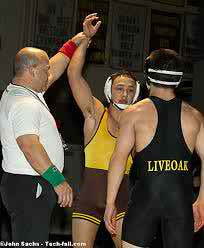Weight Training for Wrestlers: Dispelling Myths & Finding Balance
Years ago, athletes in most sports abhorred the thought of using weight training as a means of increasing strength for performance. Even in professional sports, coaches used to warn their athletes that the use of heavy movements such as bench press, squats, and deadlifts would cause athletes to become “muscle bound” and too slow, thick and bulky. It took a few decades for most people to see the advantages of intelligent weight training on sports performance, but today most athletes, trainers and coaches agree weight lifting is a key component for building strength, stamina and speed, which are useful in most sports.
There are still some sports where athletes are cautious about the use of weight lifting – particularly wrestling. Some argue becoming too strong, bulky or blocky will make a wrestler slower on the mats. They see the use of weights as a one-way ticket to being slow and bulky. Of course, seeing some of the best athletes on the mats train with weights regularly is sure to change some minds. And being pinned by someone that obviously trains and dominates on strength can open up some eyes too! Let’s look at a few strategies for using weight training effectively for wrestlers.
Watch the diet
Often, critics will argue that training with weights will cause rapid weight gain, preventing the wrestler from “making weight”. As most people know, muscle weighs a great deal more than fat – in fact, five times more than fat. And yes, training wight weights, coupled with a caloric surplus, will lead to weight gains. It’s why most people exercise in the first place! Wrestlers are always watching the scale, fearful of gaining too much weight for fear they won’t be able to make their weight class. However, it is important to remember that muscle gain is primarily controlled through diet. If you don’t eat a surplus of calories, your body will not put on weight. It’s not scientifically possible! Since wrestlers are very active – drills and running and matches on top of weight training – it’d take a great deal of deliberate eating for the wrestler to add 2, 4, or more pounds to their frame with weight lifting, providing they keep their caloric intake steady. If anything, they might lose weight by adding weight training to their routine! Keep the diet steady while weight training and no noticeable weight gain will be seen.
Choose the right movements
Exercise selection is very important for the wrestler. Choose from the top compound lifts which target multiple muscle groups while at the same time delivering useful strength. Bench press, deadlifts, squats, shoulder presses, and cleans are ideal movements for adding quality size and strength for the wrestler, so that he/she can be much stronger on the mats. The use of multiple stations of the smaller isolation movements can not only waste time, but also recovery resources that the body could be using to heal. Plus, one could argue that if you have energy remaining for incline, high rep, isolation this or that – then you didn’t work hard enough during the hour of heavy compound movements you were utilizing. Get in the gym, hit the heavy movements hard, and get out!
Watch your repetition ranges
Training with repetition ranges from 1 to 5 reps per set places your body in a very precarious situation – you are targeting brute strength almost exclusively, and risking injury to joints and tendons as well. Your muscles aren’t doing the work here – your tendons are. The wrestler is training not to add bulk, but to improve muscle quality, performance and endurance. Stick with repetition ranges of 8 to 15. The weights will be a bit lighter, but your risk of injury will drop significantly. Additionally, you will target those slow-twitch muscle fibers which aren’t recruited using low-repetition training, but are VERY useful in long wrestling matches. Going heavy now and then is great for pure strength, but powerlifter-style trainer will not serve you well in long matches.
Find balance
Remember that you are training first and foremost to become a more effective and efficient wrestler. You wish to gain strength, speed, and power, and lifting weights will definitely provide this. However, spending 6 days a week in the gym means you aren’t spending 6 days a week perfecting your wrestling craft. Use weight training as a tool for improvement without allowing it to move to the top of your priority list. You may find bodybuilding to be a wonderful outlet for you later, but at this moment, your goal is to be the best wrestler possible. Limit your weight training sessions to 3 times each week, and leave everything in the weight room for those training sessions.
As long as the wrestler trains with the correct movements, keep diet consistent, and is cautious to remember that weight lifting is a useful tool – but not the emphasis – he or she can enjoy a great deal of benefits from the use of compound weight movements. Run drills, run laps, and run around the weight room – balance is the key to success when integrating weight training into a wrestling training program. Good luck!




